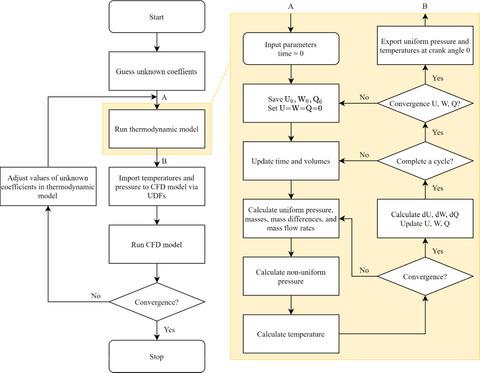当前位置:
X-MOL 学术
›
Energy Sci. Eng.
›
论文详情
Our official English website, www.x-mol.net, welcomes your feedback! (Note: you will need to create a separate account there.)
Exchanging data between computational fluid dynamic and thermodynamic models for improving numerical analysis of Stirling engines
Energy Science & Engineering ( IF 3.8 ) Pub Date : 2021-08-23 , DOI: 10.1002/ese3.965 Chin-Hsiang Cheng, Duc-Thuan Phung
Energy Science & Engineering ( IF 3.8 ) Pub Date : 2021-08-23 , DOI: 10.1002/ese3.965 Chin-Hsiang Cheng, Duc-Thuan Phung

|
In a numerical analysis of a Stirling engine, the thermal and flow fields in the cylinder are three-dimensional and periodically varying. Therefore, a computational fluid dynamic (CFD) analysis may provide detailed solution but it takes a long computation time to simulate enough number of cycles toward the final stable oscillatory regime. On the contrary, a thermodynamic model is relatively time-effective; however, it is not sufficiently accurate because it is built under some ideal assumptions. In this study, a method of exchanging data between the two models is proposed to facilitate the simulation of Stirling engines. In this method, the CFD model provides some coefficients required by the thermodynamic model. The simulation is then advanced to the stable oscillatory regime by the thermodynamic model. The information of the stable oscillatory regime predicted by the thermodynamic model is introduced back to the CFD model to renew its initial guesses. Then, the CFD model corrects the required coefficients for the thermodynamic model. The iteration of prediction-and-correction continues until the exchanged information converges. Since the predicted initial guesses of the CFD analysis by the thermodynamic model are actually very close to the solutions in the stable oscillatory regime, the CFD model can achieve detailed solutions for the stable oscillatory regime in just a finite number of cycles. In this manner, the overall time consumption can be dramatically reduced and accuracy of the CFD analysis can be improved as well.
中文翻译:

在计算流体动力学和热力学模型之间交换数据以改进斯特林发动机的数值分析
在斯特林发动机的数值分析中,气缸中的热场和流场是三维的并且周期性变化。因此,计算流体动力学 (CFD) 分析可以提供详细的解决方案,但需要很长的计算时间来模拟足够数量的循环以达到最终稳定的振荡状态。相反,热力学模型的时间效率相对较高;然而,它不够准确,因为它是建立在一些理想假设下的。在这项研究中,提出了一种在两个模型之间交换数据的方法,以促进斯特林发动机的模拟。在这种方法中,CFD 模型提供了热力学模型所需的一些系数。然后通过热力学模型将模拟推进到稳定的振荡状态。由热力学模型预测的稳定振荡状态的信息被引入回 CFD 模型以更新其初始猜测。然后,CFD 模型修正热力学模型所需的系数。预测和校正的迭代继续进行,直到交换的信息收敛。由于热力学模型对 CFD 分析的预测初始猜测实际上非常接近稳定振荡状态下的解,因此 CFD 模型可以在有限的循环次数内获得稳定振荡状态的详细解。通过这种方式,可以显着减少整体时间消耗,并且还可以提高 CFD 分析的准确性。CFD 模型修正了热力学模型所需的系数。预测和校正的迭代继续进行,直到交换的信息收敛。由于热力学模型对 CFD 分析的预测初始猜测实际上非常接近稳定振荡状态下的解,因此 CFD 模型可以在有限的循环次数内获得稳定振荡状态的详细解。通过这种方式,可以显着减少整体时间消耗,并且还可以提高 CFD 分析的准确性。CFD 模型修正了热力学模型所需的系数。预测和校正的迭代继续进行,直到交换的信息收敛。由于热力学模型对 CFD 分析的预测初始猜测实际上非常接近稳定振荡状态下的解,因此 CFD 模型可以在有限的循环次数内获得稳定振荡状态的详细解。通过这种方式,可以显着减少整体时间消耗,并且还可以提高 CFD 分析的准确性。由于热力学模型对 CFD 分析的预测初始猜测实际上非常接近稳定振荡状态下的解,因此 CFD 模型可以在有限的循环次数内获得稳定振荡状态的详细解。通过这种方式,可以显着减少整体时间消耗,并且还可以提高 CFD 分析的准确性。由于热力学模型对 CFD 分析的预测初始猜测实际上非常接近稳定振荡状态下的解,因此 CFD 模型可以在有限的循环次数内获得稳定振荡状态的详细解。通过这种方式,可以显着减少整体时间消耗,并且还可以提高 CFD 分析的准确性。
更新日期:2021-08-23
中文翻译:

在计算流体动力学和热力学模型之间交换数据以改进斯特林发动机的数值分析
在斯特林发动机的数值分析中,气缸中的热场和流场是三维的并且周期性变化。因此,计算流体动力学 (CFD) 分析可以提供详细的解决方案,但需要很长的计算时间来模拟足够数量的循环以达到最终稳定的振荡状态。相反,热力学模型的时间效率相对较高;然而,它不够准确,因为它是建立在一些理想假设下的。在这项研究中,提出了一种在两个模型之间交换数据的方法,以促进斯特林发动机的模拟。在这种方法中,CFD 模型提供了热力学模型所需的一些系数。然后通过热力学模型将模拟推进到稳定的振荡状态。由热力学模型预测的稳定振荡状态的信息被引入回 CFD 模型以更新其初始猜测。然后,CFD 模型修正热力学模型所需的系数。预测和校正的迭代继续进行,直到交换的信息收敛。由于热力学模型对 CFD 分析的预测初始猜测实际上非常接近稳定振荡状态下的解,因此 CFD 模型可以在有限的循环次数内获得稳定振荡状态的详细解。通过这种方式,可以显着减少整体时间消耗,并且还可以提高 CFD 分析的准确性。CFD 模型修正了热力学模型所需的系数。预测和校正的迭代继续进行,直到交换的信息收敛。由于热力学模型对 CFD 分析的预测初始猜测实际上非常接近稳定振荡状态下的解,因此 CFD 模型可以在有限的循环次数内获得稳定振荡状态的详细解。通过这种方式,可以显着减少整体时间消耗,并且还可以提高 CFD 分析的准确性。CFD 模型修正了热力学模型所需的系数。预测和校正的迭代继续进行,直到交换的信息收敛。由于热力学模型对 CFD 分析的预测初始猜测实际上非常接近稳定振荡状态下的解,因此 CFD 模型可以在有限的循环次数内获得稳定振荡状态的详细解。通过这种方式,可以显着减少整体时间消耗,并且还可以提高 CFD 分析的准确性。由于热力学模型对 CFD 分析的预测初始猜测实际上非常接近稳定振荡状态下的解,因此 CFD 模型可以在有限的循环次数内获得稳定振荡状态的详细解。通过这种方式,可以显着减少整体时间消耗,并且还可以提高 CFD 分析的准确性。由于热力学模型对 CFD 分析的预测初始猜测实际上非常接近稳定振荡状态下的解,因此 CFD 模型可以在有限的循环次数内获得稳定振荡状态的详细解。通过这种方式,可以显着减少整体时间消耗,并且还可以提高 CFD 分析的准确性。


























 京公网安备 11010802027423号
京公网安备 11010802027423号